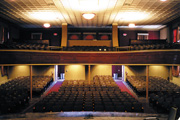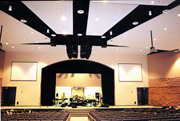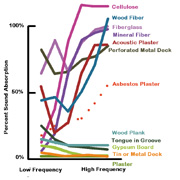

The meaning of "acoustical" eludes ceiling contractors also, where most are sure that it refers to a suspended grid of mineral fiber ceiling tiles: it doesn't. Any Webster's will set you straight on the true meaning (and spelling; only two c's, not in the same place) of the word. Acoustics is "the branch of physics dealing with sound and the qualities of a room, etc., that determine how clearly sounds can be heard in it." Acoustical is "having to do with hearing or acoustics." Therefore, since all materials in a room affect that room's acoustics, all ceilings are acoustical. Each type of ceiling is a different tool in the acoustical consultant's kit that he or she uses to balance and shape the acoustics of the project.
The hardest acoustical ceiling, and therefore the least absorbing one, is painted plaster. A hard plaster surface having its pores closed by a coat of paint only absorbs about 2 percent of the sound energy that hits it. For this reason, it is used for surfaces from where hard reflections are needed or in large rooms in which a large reverberation time is desired. Once the common method of ceiling finishing, plastering is now considered an art and a labor-intensive luxury. Cast plaster tiles allow a limited use of this acoustical ceiling material without the large labor cost.
Slightly more absorbing due to its ability to flex, metal ceilings are found in the majority of modern-day gymnasiums and other big ceiling projects.

Absorption is based on the projected area of the ceiling. Certain fibrous materials, due to their porosity, present more surface area to sound than just their projected area. This gives rise to practical sound absorptions above 100 percent. It is analogous to the surface area of a corrugated filter being much larger than its projected area.
Natural noise
Unfortunately, gymnasiums are not the type of room that can tolerate large reverberation times, and so the ceiling is usually modified to make it more sound absorbing. Depending on the project, other modifications may be needed since metal ceiling decks produce noise when the sun's heat causes them to expand and when raindrops impact their thin surfaces.Tin ceilings have the same absorbing characteristics as modern metal deck. Since their use is limited to smaller areas not exposed to the effects of sun and rain, they do not suffer from the same self-noise drawbacks.
Gypsum board is a hard acoustical ceiling surface that is useful in rooms too small to develop a reverberation field and in large rooms as a substrate for a skim coat of plaster or other acoustical ceiling material.
Wood tongue-in-groove acoustical ceilings are one of the few acoustical ceilings that absorb more low-frequency sound than high-frequency sound. This makes them a popular choice when designing rooms to look and sound "warm." Spaces can be left between boards to add absorption or diffusion to the room.
Common in curved-truss churches built in the early 1960s, 4-by-6 wood-plank acoustical ceilings combine well-balanced sound absorption inside the church with good sound insulation from rain and outside noise into a simple, albeit heavy, unit.
Used extensively in the 1950s and '60s, asbestos acoustical plaster was a simple and ubiquitous solution for acoustical consultants. A quick look at figure 1 shows why. Every part of the graph is covered except at the center, right where only the asbestos plaster operates. Having eliminated the asbestos fill and replaced it with poly foam has increased acoustic plaster's high-frequency absorption and left a large hole in the consultant's bag of tricks.
Sound-absorbing holes
One solution to the hard surface of metal deck is perforated metal deck. Holes in the surface of this deck lead to an air cavity filled with fiberglass insulation. The resulting Helmholtz resonator/absorber is designed to give a relatively flat absorption curve, absorbing about 70 percent of all sound energy hitting it.The most square feet of ceiling in the United States is suspended lay-in mineral fiber tiles. Its popularity is due to its low labor costs, compatibility with lighting and HVAC components and clean look.
Fiberglass lay-in tile is as convenient as mineral fiber, but more absorbing in the low-frequency range. Because of its increased cost, fiberglass is used only in rooms requiring this extra bass absorption. An added feature of fiberglass tile is its availability in three-dimensional panels. This allows the ceiling to be tiered or coffered to introduce sound diffusion to the room.
Wood fiber lay-in panels are the third option for use in a suspended T grid ceiling. These panels add a bit of the "warm" sound of wood to the room but are more convenient to install than tongue-in-groove or wood plank. Roof panel systems are also available with integral wood fiber ceilings for use in large ceiling areas.
A good choice of acoustical ceiling for rooms having large ceilings is spray-applied cellulose. Sprayed to a thickness of only 1 inch, it exceeds all other acoustic ceilings for sound absorption.
Comparing the sound absorption curves of each of the acoustical ceilings shows that each ceiling has its own signature, unlike any other. Although the choices are adequate, there is room for ceiling materials yet to be invented. There is a need for a ceiling to fill in the gap left by the elimination of asbestos plaster. A closer study of figure 1 also suggests that there is a need for acoustical ceilings like tongue-in-groove that absorb more low frequencies than high.
No one ceiling is the solution to all projects; each is suited for a particular job.


Report Abusive Comment